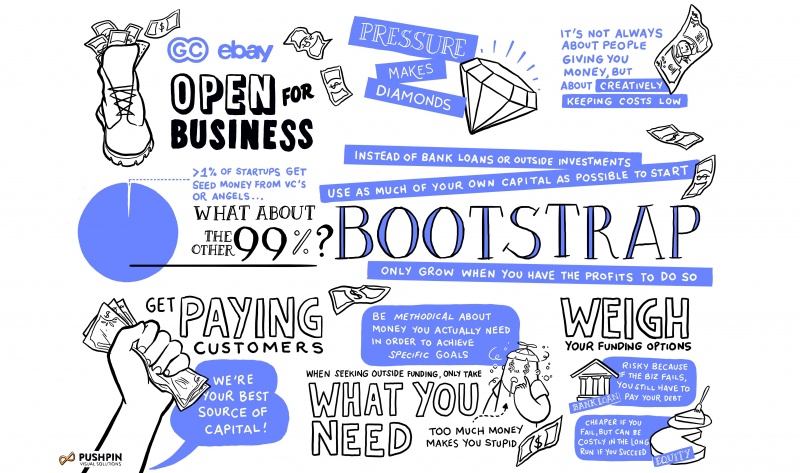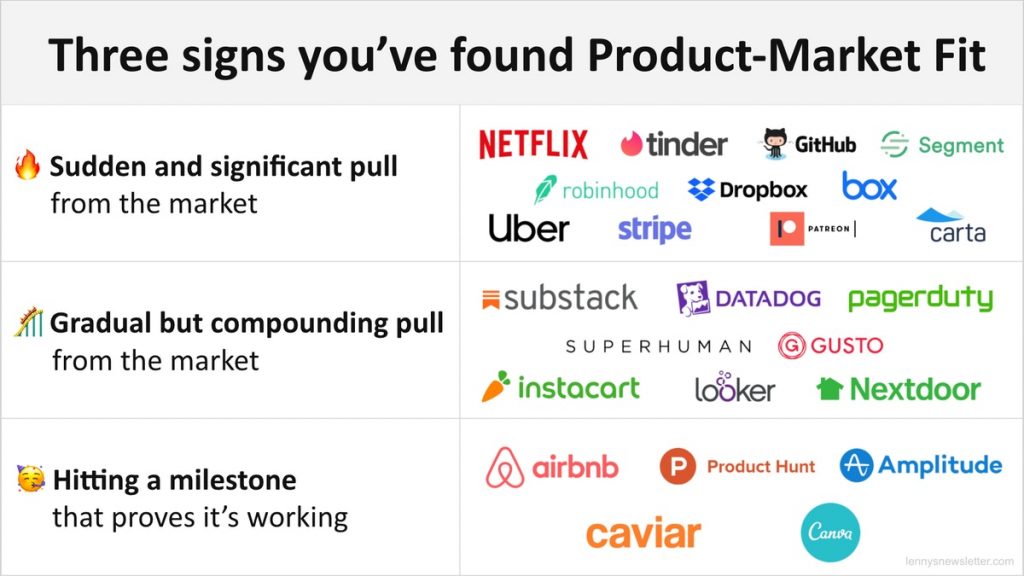Why its sometimes better to bootstrap your startup instead of seeking out investors early on
Recently I came across an article written in Entrepreneur Mag by a contributor named Naveen Dittakavi, that was titled “Why Seeking Out Investors Could Sabotage Your Business”. He makes the argument, that instead of pitching investors (early on) to help fund and develop your startup’s product, there are many tangible benefits to “bootstrapping” it, such as:
- Forces you to cut the fluff from day one
- maintain full control & ownership of your company
- There are valuable lessons that come with working on and perfecting a product or service to make sure it is useful to your target customers since your company needs to generate revenue and cash to survive
What is Bootstrapping?

(image credit: EBay Open for Business series)
Bootstrapping your business means getting it up and running (and hopefully successful) without the help of any external investors, such as venture capitalists and angel investors. It means relying on your own savings and revenue to operate and expand. It’s not easy to do, but it’s incredibly rewarding.
Matt Turck an early-stage VC, wrote an article about this subject and explains that bootstrapping can take many forms, including:
- You never raise venture or private equity money (but you use credit cards, vendor credits, debt and/or raise from friends or family)
- You raise a small seed amount from VCs and then basically never raise again
- Or you don’t raise anything for a number of years (like 5-10) and then you raise a very large round (that sometimes people call a Series A, but in reality it has nothing to do with your usual Series A).
The CNBC business reality program called Shark Tank sort of glorifies the idea of becoming an entrepreneur, and if you watch a few episodes it might make you think that it is easy. Mr. Dittakavi said, “you come up with an idea, make a few sales, go after a bunch of people that have money to burn, and the rest will just work itself out… right?”
We know this is not exactly how it works. He references and cites a book by author Jonathan Siegel titled The San Francisco Fallacy: The Ten Fallacies That Make Founders Fail, which argues that quite often founders and entrepreneurs actually lean too heavily on investor funding to bring their ideas to life. As a result, they don’t learn the valuable lessons that come with working on and perfecting a product. Burning someone else’s cash day in and day out can turn your business into a ticking time bomb.
In his article he also cites his own experience as startup founder of a travel industry software firm called Next Vacay, stating that being in a hyper-competitive industry “I have to stay on my toes constantly. The instincts I honed from bootstrapping our operation help me make big decisions each and every day.”
For the past few decades, startups have raised money from investors in the hopes of scaling their business to a billion dollars (unicorn) and beyond.
If we look back at the 2019 Forbes Cloud 100 list, we see that over 90% of this list has raised some kind of funding to kickstart their business. This leaves a smaller subsection of startups that have raised no money. These days, many news headlines paint a picture of venture capital and angel investors infusing startups with millions of dollars. The reality, however, is quite different. According to an article in Ebay’s series called “Open for Business” (that highlights small business success stories), data from the Small Business Administration recently found that only 1% of startup businesses get seed money from venture capitals or angel investors.
And many of these startups that have done so and grown their company are often sought after down the line due to their ability to create revenue, cash flow, and product-market fit without needing investor cash.
Even if some of these have done smaller raises down the line, these startups have retained majority control of their own company and have since either been acquired, IPOed, or still going full steam ahead.
One bootstrapped startup Unicorn was just in the news, The financial software firm Intuit, (parent company of Credit Karma QuickBooks, TurboTax, Mint) announced that it is acquiring the email marketing software startup Mailchimp in a $12 billion deal. For co-founders Ben Chestnut and Dan Kurzius, the cash and stock acquisition amount to a big payday that is 20 years in the making. Forbes noted that the Atlanta-based company’s email marketing tools cater to small businesses, and its founders have maintained a small business philosophy even as the company ballooned to revenues (13 million total users globally and 800,000 paid customers) that reached $800 million last year. That philosophy has come most notably through the founders’ decision to reject outside investments entirely, instead choosing to bootstrap the company through their own mettle. As a result, Chestnut and Kurzius each hold a 50% stake in the company. The deal entails $300 million in employee bonuses, meaning the remaining $11.7 billion, evenly split between cash and Intuit stock, will be paid out to the two co-founders. After accounting for taxes on the cash received, the duo is estimated to be worth $5 billion apiece.
And on this news, CB Insights sent an email newsletter that said “in the current bonkers funding environment, a quick reminder: Funding buys you time. It doesn’t buy you the ability to execute.”
Two cases in point (from the “our customers are our investors” school of thinking):
- Mailchimp, co-founded by Ben Chestnut and Dan Kurzius 21 years ago.
The email marketing platform received no outside investment and was acquired for $12B this week. $800M in revenue.
- PrettyLitter, founded by Daniel Rotman.
The Direct to Consumer cat litter brand raised $1M from investors since its founding and got acquired by Mars inc exited for up to $1B according to reporting from Bloomberg.
Now, these are some entrepreneurs.
Mr Dittakavi said in his article “if investor capital seems like the only answer to getting started as an entrepreneur, heed the advice below on what you should be doing instead.”
Why investors won’t save a broken value proposition or product-market fit

(image credit: Lennysnewsletter)
The #1 reason startups fail is that they run out of money before achieving product-market fit. Simple as that. Once you have product-market fit, funding is usually dramatically easier.
There are many different definitions of product-market fit, but in essence, they all revolve around three basic components: identified customers who want your solution, in a market large enough to justify the business. Gigi Levy-Weiss, a General Partner at NFX, a seed-stage venture firm, describes it as “Simply put, product-market fit is that magical moment when you become a must-have in your customers’ minds. This happens when you solve a real problem for them or help them do something 10x better, or you allow them to do something they couldn’t do before.”
One of the reasons testing your offer is unpopular is that it’s not what we see in mainstream media when we think of entrepreneurship. Too often the media only writes about or highlights the stories of wildly successful buyouts or jaw-dropping IPOs; which can make people think that brilliant, innovative products just appear to have come out of nowhere.
One reason is that validating your product promise wasn’t easy to do (and sometimes not possible) even just a few years ago. It’s the emergence of better targeted and more segmented advertising platforms like Facebook that make this so easy to do today.
Behind the scenes of all of these success stories are many years of testing, failing, and learning. If you’re too afraid to test your value proposition to see if people even want it, why should people even pay you in the first place?
Mr. Dittakavi also said “think about it. You need persuasion skills to be successful in pitching investors. Why can’t you just use those same persuasion skills to sell your product to your market instead? Trust me: If you’re making sales and taking market share, that information is more interesting to investors than flashy language on a pitch deck.”
Have you ever heard of a stock image website called Shutterstock? According to an article in Medium, it is known as one of the earliest stock image sites, Shutterstock was launched in 2003 by Jon Oringer, a software developer and amateur photographer.
Although working as a coder was of interest, one other thing interested him even more, and that was making money. Oringer was always creating new applications and marketing to his own email list a variety of products to buy. He did this while working on his master’s degree but soon realized that products sold better if you attached photos with them.
However, photos were super expensive to use, so he decided to take his own photos with a Canon he bought. This soon prompted him to realize that other entrepreneurs on the web might want stock photos as he did. With this, he put together the odd 30 000 photos he had already taken and paywalled it behind a website with a $49 monthly subscription for unlimited use.
This soon blew up, and Oringer expanded his services by adding on contributors beyond himself. This was all bootstrapped with Oringer raising a small round only once (mainly to help scale his management team) and still maintains close to a 50% ownership of the company by himself.
Today Shutterstock is worth over 2.5 billion dollars since IPOing in 2012. That surely is an impressive run for a solo founder whilst bootstrapping his service. One of the main reasons he never had to raise a funding round was that he achieved product-market fit relatively early on, where demand exceeded his own photo supply.
Failure is always an option
A founder named Aytekin Tank published an article in Entrepreneur where he states that “I don’t need to tell you that a huge percentage of startups fail within their first year. It can be disheartening, to put it mildly, to pour everything you’ve got into a business only to watch it crumble before your eyes.”
But successful entrepreneurs understand that failure is inevitable. No matter how well-laid your plans, no matter how hard you work, the fact is that things won’t go as you expect them to. Being willing to adapt to changing circumstances is every bit as important as having a winning idea — probably even more so.
Another fallacy mentioned by the author Jonathan Siegel in his book is the idea that “failure is not an option”, (which according to Wikipedia was said by Gene Kranz about the Apollo 13 Moon landing mission). Actually, failure *is* an option — and it’s completely necessary for business. If you have investors breathing down your neck to figure it all out as quickly as possible, you’ll be tempted to cut corners or ship a version of your product that doesn’t work or doesn’t scale. Shipping your product before you feel totally ready can be good, but shipping simply to say you didn’t fail is a red flag.
Mr Dittakavi suggests that instead, you should embrace failure. Poke holes in your value proposition. Practice pitching your concept to trusted mentors or even investors — but don’t take their money just yet. Get raw feedback on where your value proposition is flimsy and you’ll have what you need to keep your product improving along the way.
How to bootstrap your startup to get it moving forward
So if investors aren’t the best way forward (at least at the beginning when you are just starting out), what should you do instead? Here is what to prioritize first as you’re getting started. Mr Dittakavi listed some pretty solid tips:
- Work on developing your minimum viable product – Get your product to the point of being minimally viable. Then keep up your obsession with it. Your product is your ultimate business card for encouraging repeat and word-of-mouth business, so ensure it has your attention.
- Make the customer experience world-class – Even if your product has kinks, great customer service will turn one-time buyers into raving fans. Make regular updates to your product to make it the best in your industry, and focus on what features your customers really want first before you add more bells and whistles.
- Research the market relentlessly – The last 18 months have shown us how quickly a market landscape can change. Do your research before you launch, but then continue to do your research as competitors or copycats emerge. Also, keep your finger on the pulse of your industry; sudden shifts in technology or availability can alter consumer tastes.
Investors can help a business accelerate its growth. But do you really want to put yourself under that kind of pressure when your product isn’t yet proven? Do the dirty work now to create an offer customers actually want, and you’ll be positioned well to grow in the future however you choose.
Conclusion
Another great example of a bootstrapped startup that became a unicorn is Mojang Studios the developers behind the popular kids game Minecraft, which never raised any venture capital, employed just 50 people and earned nearly a billion dollars in profit before selling to Microsoft. Minecraft grew by charging users a flat fee, resulting in a $2.5 billion acquisition.
The startup examples mentioned in this article that began by bootstrapping it themselves and went on to create huge companies without the need for investor money is quite inspirational. Although a couple did make some money eventually, none of them needed to, and the rounds raised were more circumstantial. Some other notable examples that Mr Turck’s article mentioned include:
- Atlassian = started in 2002, no VC raised, IPO in 2015
- Github = started in 2008, bootstrapped until $100M Series A in 2012, acquired by Microsoft in 2018
- Pluralsight = started in 2004, bootstrapped until Series A in 2013, IPO in 2018
- Dyn = started in 1998, bootstrapped until Series A in 2012, acquired by Oracle in 2016
- Automation Anywhere = started in 2003, bootstrapped until S250M Series A in 2018
- Blue Prism = started in 2001, almost entirely bootstrapped until 2016 IPO (apparently a $2.35M venture round in 2015)
- Squarespace
- Basecamp
In a time where there are so many angels and VCs in the market, startup founders sometimes misjudge that they think they need to raise a round. Although some technology or biotech might need funds to get started, most products in the market can be bootstrapped.
Whether you are a bootstrapped small business or are investor funded Huckabee CPA’s cloud-based financial services can scale with your growing startup so that you get the right accounting, tax, and CFO advisory support at the time you need it. Feel free to reach out with any questions or for a free consultation.











